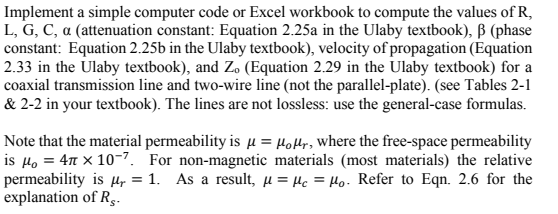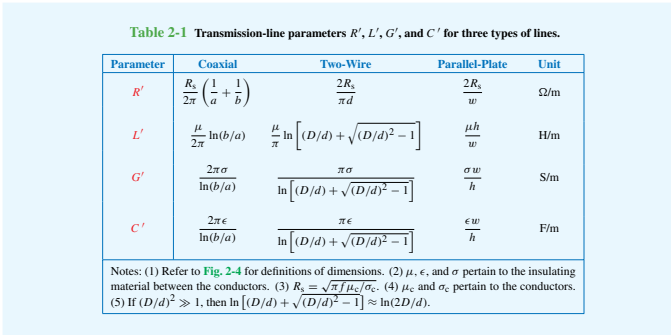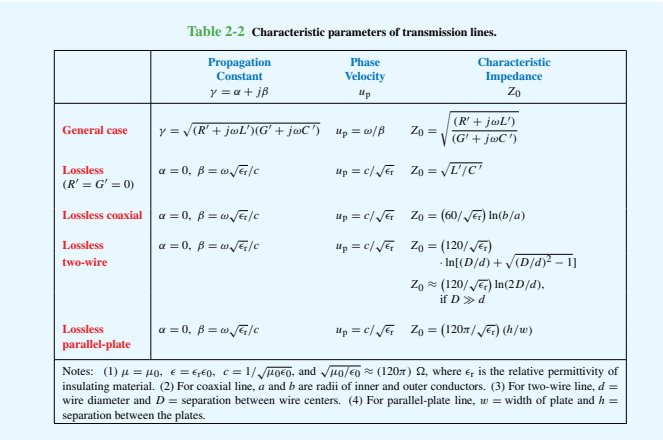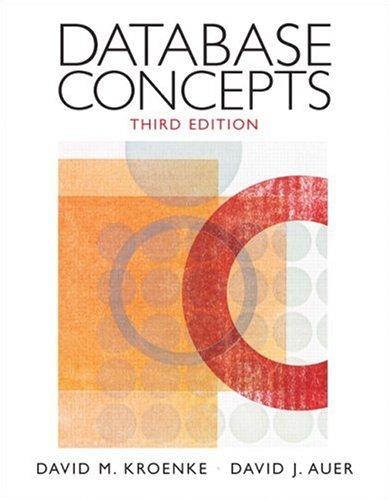Answered step by step
Verified Expert Solution
Question
1 Approved Answer
Please use Excel. I made a version in Python but would like to know how to use excel. Thanks. Implement a simple computer code or




Please use Excel. I made a version in Python but would like to know how to use excel. Thanks.
Implement a simple computer code or Excel workbook to compute the values of R, L, G, C, a (attenuation constant: Equation 2.25a in the Ulaby textbook), B (phase constant: Equation 2.25b in the Ulaby textbook), velocity of propagation (Equation 2.33 in the Ulaby textbook), and Z. (Equation 2.29 in the Ulaby textbook) for a coaxial transmission line and two-wire line (not the parallel-plate). (see Tables 2-1 & 2-2 in your textbook). The lines are not lossless: use the general-case formulas. Note that the material permeability is u = Holly, where the free-space permeability is Ho = 411 x 10-7. For non-magnetic materials (most materials) the relative permeability is Hy = 1. As a result, u = He = Ho. Refer to Eqn. 2.6 for the explanation of Rs Also note, similarly, that the permittivity is = ., where the free-space vity is , = 8.854 x 10-12 and the relative permittivity is e(the relative permittivity is l in free space, but is generally larger than 1 in other materials) Table 2-1 Transmission-line parameters R', L', G', and C' for three types of lines. Coaxial Two-Wire Parallel-Plate Unit S2/m | moja 5m[Dya) + VD70)2-1] H/m 2 In(b/a) In[(D/a)+(D/a)2 - 1 JTE wfw0w1 46001 - F/m In(b/a) In(D/a)+(D/)2 - 1 Notes: (1) Refer to Fig. 2-4 for definitions of dimensions. (2), , and a pertain to the insulating material between the conductors. (3) R= V fHc/c (4) Me and oc pertain to the conductors. (5) If (D/d) > 1, then In [(D/d) + (D/d) - 1) In(2D/d). Table 2-2 Characteristic parameters of transmission lines. Propagation Constant y=a+jB Phase Velocity Characteristic Impedance up Zo General case y = (R' + jwL')G' + jwC') p = w/B 20" Zo = (R' + jwL') G' + jwC Lossless (R' = G' =0) a=0, B=w.VET/C up = c/J Zo = LIC Lossless coaxial a=0, B=w.VET/C up = c/ = c/V Lossless two-wire a = 0, B = w/6/ Zo = (60/7) In(b/a) Zo = 120/16) In[(D/d) + (D/d)2 - 1] zo (120/16) In(2D/d), if Dxd Lossless parallel-plate a=0, B=w/6/C up = c// 20 = (1201/ /) (h/w) Notes: (1) = 0, = 0, C=1/ 00, and O/0 (120) 2, where is the relative permittivity of insulating material. (2) For coaxial line, a and b are radii of inner and outer conductors. (3) For two-wire line, d = wire diameter and D = separation between wire centers. (4) For parallel-plate line, w = width of plate and h= separation between the plates. Implement a simple computer code or Excel workbook to compute the values of R, L, G, C, a (attenuation constant: Equation 2.25a in the Ulaby textbook), B (phase constant: Equation 2.25b in the Ulaby textbook), velocity of propagation (Equation 2.33 in the Ulaby textbook), and Z. (Equation 2.29 in the Ulaby textbook) for a coaxial transmission line and two-wire line (not the parallel-plate). (see Tables 2-1 & 2-2 in your textbook). The lines are not lossless: use the general-case formulas. Note that the material permeability is u = Holly, where the free-space permeability is Ho = 411 x 10-7. For non-magnetic materials (most materials) the relative permeability is Hy = 1. As a result, u = He = Ho. Refer to Eqn. 2.6 for the explanation of Rs Also note, similarly, that the permittivity is = ., where the free-space vity is , = 8.854 x 10-12 and the relative permittivity is e(the relative permittivity is l in free space, but is generally larger than 1 in other materials) Table 2-1 Transmission-line parameters R', L', G', and C' for three types of lines. Coaxial Two-Wire Parallel-Plate Unit S2/m | moja 5m[Dya) + VD70)2-1] H/m 2 In(b/a) In[(D/a)+(D/a)2 - 1 JTE wfw0w1 46001 - F/m In(b/a) In(D/a)+(D/)2 - 1 Notes: (1) Refer to Fig. 2-4 for definitions of dimensions. (2), , and a pertain to the insulating material between the conductors. (3) R= V fHc/c (4) Me and oc pertain to the conductors. (5) If (D/d) > 1, then In [(D/d) + (D/d) - 1) In(2D/d). Table 2-2 Characteristic parameters of transmission lines. Propagation Constant y=a+jB Phase Velocity Characteristic Impedance up Zo General case y = (R' + jwL')G' + jwC') p = w/B 20" Zo = (R' + jwL') G' + jwC Lossless (R' = G' =0) a=0, B=w.VET/C up = c/J Zo = LIC Lossless coaxial a=0, B=w.VET/C up = c/ = c/V Lossless two-wire a = 0, B = w/6/ Zo = (60/7) In(b/a) Zo = 120/16) In[(D/d) + (D/d)2 - 1] zo (120/16) In(2D/d), if Dxd Lossless parallel-plate a=0, B=w/6/C up = c// 20 = (1201/ /) (h/w) Notes: (1) = 0, = 0, C=1/ 00, and O/0 (120) 2, where is the relative permittivity of insulating material. (2) For coaxial line, a and b are radii of inner and outer conductors. (3) For two-wire line, d = wire diameter and D = separation between wire centers. (4) For parallel-plate line, w = width of plate and h= separation between the platesStep by Step Solution
There are 3 Steps involved in it
Step: 1

Get Instant Access to Expert-Tailored Solutions
See step-by-step solutions with expert insights and AI powered tools for academic success
Step: 2

Step: 3

Ace Your Homework with AI
Get the answers you need in no time with our AI-driven, step-by-step assistance
Get Started


